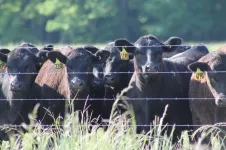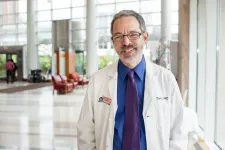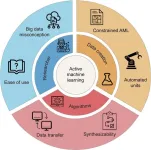(Press-News.org) URBANA, Ill. — As we hurtle toward crucial tipping points on a warming planet, an international team of scientists is recruiting a surprising ally to make a powerful dent in greenhouse gas emissions: the cow. Animal sciences researchers from the University of Illinois Urbana-Champaign are driving a new project to reduce methane production resulting from rumen fermentation in beef and dairy cattle. The 3-year, $3.2-million project is part of the Greener Cattle Initiative, led by the Foundation for Food and Agriculture Research (FFAR).
According to the researchers, aggressively targeting methane could help course-correct our climate trajectory on a quicker timeline than controlling carbon dioxide (CO2) alone. Methane is 28 times more potent than CO2 and degrades in the atmosphere within a dozen years, compared to the hundreds of years it takes CO2 to dissipate.
“What this means is that anything we do now with ruminant animals can have a huge impact on warming within decades, rather than centuries. Our challenge is to reduce enteric methane emissions by about 30 to 40% with the technologies we have,” said project leader Rod Mackie, professor in the Department of Animal Sciences, part of the College of Agricultural, Consumer and Environmental Sciences (ACES) at U. of I. Mackie is also affiliated with the Division of Nutritional Sciences in ACES and the Carl R. Woese Institute of Genomic Biology.
The project involves six research hubs around the world, all tackling the challenge of enteric methane, which is produced in the rumen as part of the microbial fermentation process. Mackie, along with Illinois animal sciences professor Josh McCann, will start by tracking hydrogen production and utilization during fermentation.
A key step in the fermentation process is the regeneration of a high-energy carrier molecule known as NADH. For microbes to keep producing energy during glycolysis, NADH has to dump its hydrogen — the H in NADH — and wait for a recycled one to take its place from breakdown of carbohydrates and other fermentable organic matter provided in the diet. Normally, the excess hydrogen from NADH is used to convert CO2 to methane, a molecule comprised of one carbon and four hydrogen atoms. However, the research team thinks there may be ways to redirect the excess hydrogens towards more productive end-products.
“In anaerobic fermentation in the rumen, you have to have some way of recycling hydrogen through the conversion of NADH to NAD. In that process, most of the excess hydrogen goes towards methane. If you shut down methane production, hydrogen builds up and inhibits glycolysis,” Mackie said. “We don't want that to happen. Instead, we want to redirect hydrogen into other products, such as propionate and butyrate, reduced fatty acids that serve as the primary energy source for all ruminants.”
McCann added, “There are a lot of groups working on inhibiting methane directly using dietary additives. Our focus is trying to figure out how we actually make it work in an animal and make it more energetically feasible. That's really been the missing piece,” he said. “If cows can’t metabolize the excess hydrogens for productive benefit and to improve growth, there will continue to be limited adoption of methane reduction strategies or additives. There's no economic incentive.”
The team will start by taking a close look at hydrogen production and utilization in the lab. They will take rumen microbial communities from beef cattle that naturally produce more or less methane to explore potential adjustments they can make to the system with promising inhibitor compounds. Later, they will bring their findings back into cows.
“Most of the grant is focused on the basic and the mechanistic side, but once we make something that might work within a microbial community, it still has to work in an animal,” McCann said. “We have complicating factors like diet components and how much they want to eat. Not to mention dairy cattle and beef cattle are eating different things, so the bugs in the rumen function differently. So, if we apply a methane inhibitor to a dairy microbial community, we might have to approach the hydrogen capture a little bit differently than in a beef rumen community.”
Mackie said the project is the beginning of a longer-term endeavor to find enteric methane solutions. But by the end of three years, the goal is to be able to recommend specific amounts of inhibitors that don’t hinder or even improve production performance.
Beyond that? “What we'd like is to have ruminants save the planet within 10 years,” he said. “That would be amazing.”
Institutions involved in the project include the University of Illinois Urbana-Champaign as the project lead; the Grasslands Research Centre, AgResearch, New Zealand; the University of Alberta; Lethbridge Research and Development Centre, Agriculture and Agi-Food Canada; the Norwegian University of Life Sciences; Queen’s University Belfast, Northern Ireland; Ben-Gurion University of the Negev, Israel; and ProAgni, Australia.
END
Illinois-led team puts cows and microbes to work to reduce greenhouse gases
2023-09-29
ELSE PRESS RELEASES FROM THIS DATE:
DOE announces $264 million for basic research in support of Energy Earthshots™
2023-09-29
WASHINGTON, D.C. — The U.S. Department of Energy (DOE) today announced $264 million in funding for 29 projects to develop solutions for the scientific challenges underlying DOE’s Energy Earthshots™ Initiative to advance clean energy technologies within the decade. The funding will support 11 new Energy Earthshot Research Centers led by DOE National Laboratories and 18 university research teams addressing one or more of the Energy Earthshots™ that are focused on six different areas, including industrial decarbonization, carbon storage, and offshore wind. The Department launched the Energy Earthshots ...
New drug a breakthrough for brain tumor that strikes young people: NEJM editorial
2023-09-29
A top UVA Health cancer expert is highlighting how a new drug could transform how doctors treat a brain tumor that typically strikes younger people.
David Schiff, MD, the co-director of UVA Cancer Center’s Neuro-Oncology Center, has authored an editorial in the prestigious New England Journal of Medicine describing the potential significance of the drug vorasidenib for patients with tumors known as “grade 2 IDH-mutant gliomas.” The drug, when tested in the INDIGO clinical trial, was found to slow tumor growth significantly and extended the average time until the tumor started growing from 11.1 months ...
Genome study reveals 30 years of Darwin’s finch evolution
2023-09-29
An international team of researchers has released a landmark study on contemporary evolutionary change in natural populations. Their study uses one of the largest genomic datasets ever produced for animals in their natural environment, comprising nearly 4,000 Darwin’s finches. The study has revealed the genetic basis of adaptation in this iconic group. The results are published in the journal Science.
Ever since Darwin wrote about the finches of the Galápagos Islands, biologists have studied these small songbirds to understand the mechanisms of evolution. One ancestral species has evolved into 18 different species in the last million years. ...
Ghent University’s research team envisions a bright future with active machine learning in chemical engineering
2023-09-29
Chemical engineering researchers have a powerful new tool at their disposal: active machine learning. In a recent perspective article published in Engineering, Kevin M. Van Geem’s research team at Ghent University explores the potential of active machine learning in revolutionizing the field of chemical engineering. By combining machine learning with the design of experiments, active machine learning promises to enhance the efficiency and cost-effectiveness of research, spanning all length scales of chemical engineering.
Active machine learning algorithms ...
Climate change and carnivores: shifts in the distribution and effectiveness of protected areas in the Amazon
2023-09-29
A new article published in PeerJ Life & Environment, authored by Camila Ferreira Leão at Universidade Federal do Pará sheds light on the effects of climate change on carnivorous mammals in the Amazon and their representation within Protected Areas (PAs). "Climate change and carnivores: shifts in the distribution and effectiveness of protected areas in the Amazon," reveals alarming findings about the vulnerable status of these animals and the effectiveness of conservation measures.
Carnivorous ...
Can ChatGPT help us form personal narratives?
2023-09-29
Research has shown that personal narratives—the stories we tell ourselves about our lives—can play a critical role in identity and help us make sense of the past and present. Research has also shown that by helping people reinterpret narratives, therapists can guide patients toward healthier thoughts and behaviors.
Now, researchers from the Positive Psychology Center at the University of Pennsylvania have tested the ability of ChatGPT-4 to generate individualized personal narratives based on stream-of-consciousness thoughts and demographic details ...
An intelligent control method reduces carbon emissions in energy-intensive equipment
2023-09-29
A research team led by Professor Tianyou Chai from Northeastern University, China, has developed an innovative intelligent control method for the low-carbon operation of energy-intensive equipment. This groundbreaking research, published in the journal Engineering, presents a significant step towards reducing carbon emissions in the process industry.
The research team’s method combines mechanism analysis with deep learning, linking control and optimization with prediction, and integrating decision-making ...
Groundbreaking control method reduces carbon emissions from zinc oxide rotary kilns, boosting profits for zinc smelting industry
2023-09-29
A research team from Central South University in China develops innovative control method to reduce carbon emissions from zinc oxide rotary kilns.
The zinc smelting industry is facing new challenges in meeting China’s carbon peak and carbon neutrality targets. To address these challenges, researchers from Central South University in China have developed a groundbreaking control method that reduces carbon emissions from zinc oxide rotary kilns while maintaining high profits. Their findings have been published in the journal Engineering.
Zinc oxide rotary kilns play a crucial role in the zinc smelting process. ...
Small but mighty new gene editor
2023-09-29
A new CRISPR-based gene-editing tool has been developed which could lead to better treatments for patients with genetic disorders. The tool is an enzyme, AsCas12f, which has been modified to offer the same effectiveness but at one-third the size of the Cas9 enzyme commonly used for gene editing. The compact size means that more of it can be packed into carrier viruses and delivered into living cells, making it more efficient. Researchers created a library of possible AsCas12f mutations and then combined selected ones to engineer an AsCas12f ...
Study finds SARS-CoV-2-associated sepsis was more common, deadly than previously thought
2023-09-29
Using data from Mass General Brigham’s electronic health records, Brigham researchers quantified the burden of SARS-CoV-2-associated sepsis early in the pandemic
New research suggests that the virus responsible for COVID-19 was a more common and deadly cause of sepsis during the initial period of the pandemic than previously assumed. The study, led by investigators from Brigham and Women’s Hospital, a founding member of the Mass General Brigham healthcare system, used electronic health record (EHR) data from five Mass General Brigham hospitals to track the rate of SARS-CoV-2-associated ...








